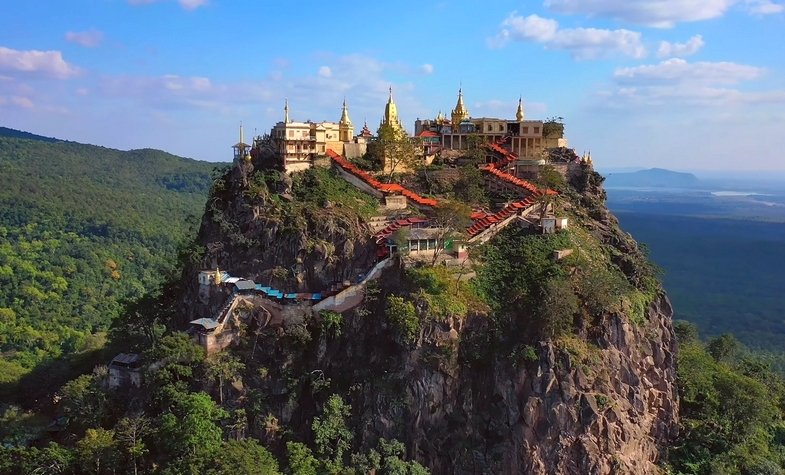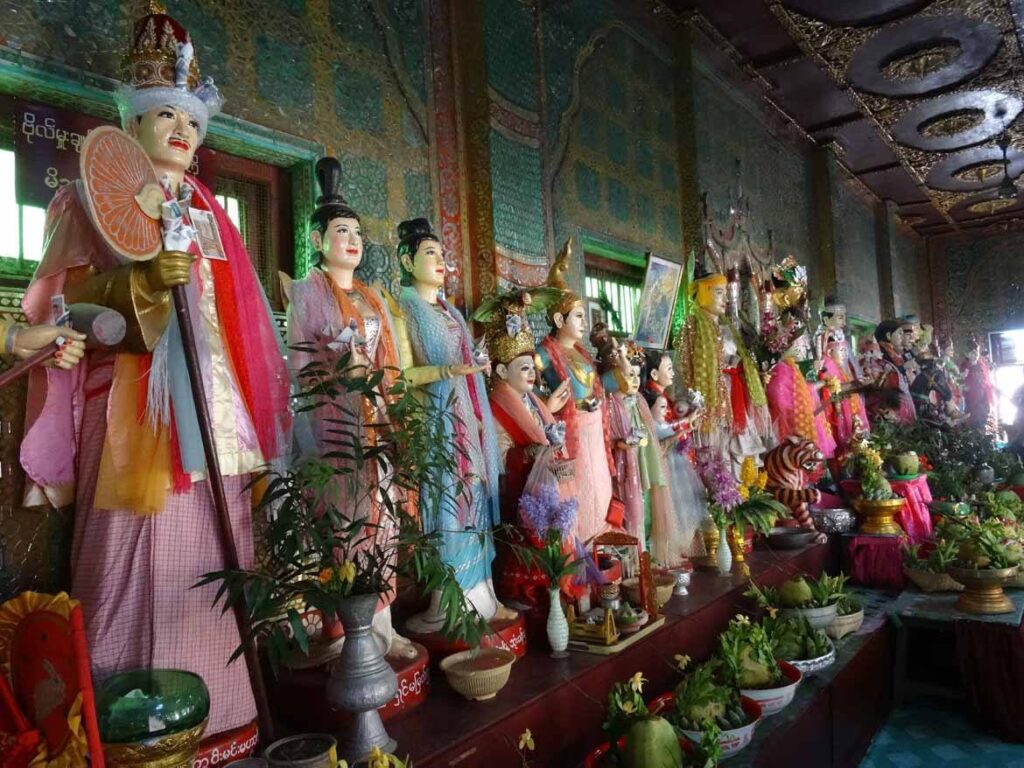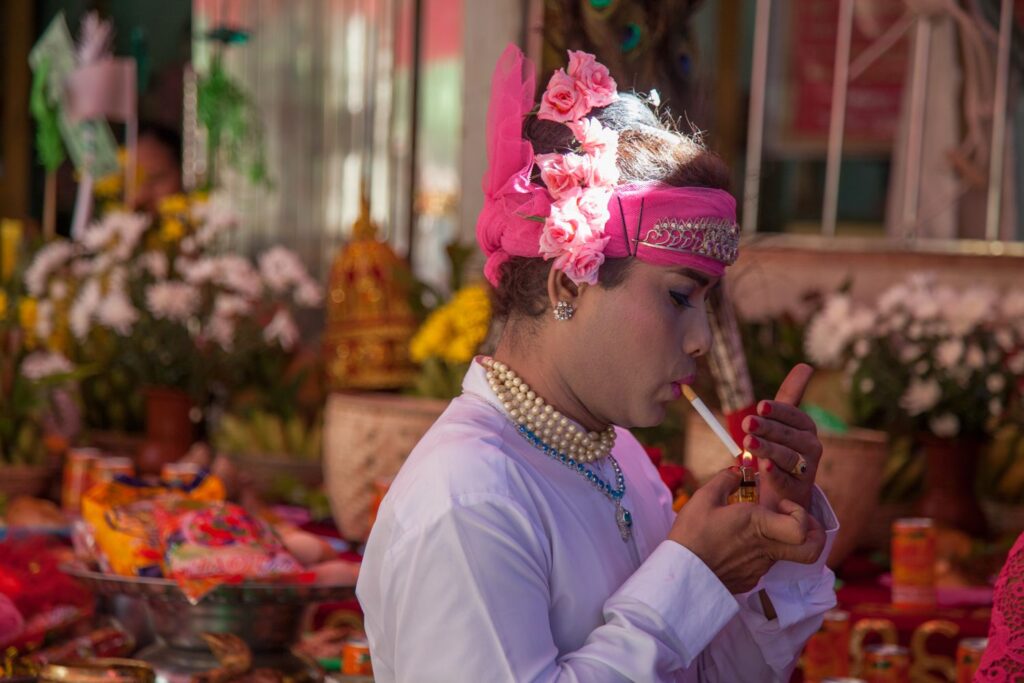Reviving Burmese Nat Shrines to Protect Myanmar’s Mount Popa National Park
Climate change activists are turning to religion to save the environment in Myanmar

(Mount Popa in Myanmar. Image source: Travel Authentic Asia)
On the morning of December 26, 2023, a willowy transgender woman huddled on a carpet in front of a wooden structure resembling a house, the size of a telephone booth, placed at the bottom of a giant fig tree in a village bordering Mount Popa National Park in central Myanmar. Her wavy hair was tied in a top knot, her eyes closed and hands supplicating in prayer. A group of people knelt around her in reverence, all draped in traditional Burmese attire. Not long afterwards she donned a purple gaung baung (turban), and danced to a series of slow beats that gradually sped up. The moment ended with her entering a trance-like state.
The assembled group was consecrating a nat shrine, called nat kun or nat sin in Burmese, and the trans woman was acting as a nat kadaw, a spirit medium. A nat, also called deva, is a spirit, and traditionally the Burmese believed in a wide array of spirits. The spirits are capable of protecting people when appeased and of causing harm when ignored or offended. Nats are terrestrial beings tied to the landscape.
The trans woman, a professional spirit medium, was hired by Mahagiri—a local non-profit group working for environmental conservation in the Mount Popa National Park—to consecrate multiple abandoned nat shrines in the fringe areas of the park. Founded in 2020 and named after Min Mahagiri (The Lord of the Great Mountain), the principal nat of Mount Popa, the organization has about a dozen young people as its members. Tin Ko Min, a 35-year-old local grassroots conservationist trained in geology, helms the organization.
Mount Popa National Park is located in Myanmar’s central dry zone, a desert-like region characterized by prickly bushes and stunted trees. One of the country’s most climate-sensitive regions, here Mount Popa’s fifty-square-mile lush forests are often likened to an oasis. The forests are not only the primary carbon sinks in the region, but also prominent biodiversity hotspots. The park hosts a total of 279 species, including the critically endangered Popa langur (Trachypithecus popa). Though these forests were designated as a national park in 1989, forest law enforcement never seriously took effect here, making informal conservation efforts even more important.
As the climate crisis hits the region, Mahagiri banks on the traditional beliefs in nats to protect the local ecology and address the climate crisis. As part of a local climate change mitigation strategy, the group is reviving the abandoned nat shrines scattered throughout Mount Popa. “Thanks to our ancestors’ beliefs, people here eschew despoiling the dwellings of nats,” Tin Ko Min tells me. “Therefore, reviving nat shrines is a good strategy to safeguard trees and forests that sequester carbon.”
Turning to religion, these climate change activists hope to provide long-term protection for a critical segment of the environment in Burma and contribute towards addressing the global climate crisis.
The Animist Nat Cult of Myanmar
In Myanmar, a majority of the population is Buddhist. A significant number of Buddhists also follow the animist nat cult that possibly predates Buddhism. The official pantheon of nats consists of thirty-seven deities called Thong Ze Khunna Min, meaning “thirty-seven spirit lords.” In addition, there are hundreds of local deities and ancestor spirits that share the landscape with human and non-human beings. Once revered on par with Buddhism, today the nat cult survives as a subculture away from Myanmar’s urban centers dominated by orthodox Buddhism.
On a breezy evening in September 2023, months before they started reviving nat shrines, I visited the office of Mahagiri, a two-story house with teak floors typical of Myanmar homes of the past. As we walked around Popaywa, located at the foothills of Mount Popa, Tin Ko Min told me that in the past the Burmese worshiped the nats of wind, fire, metals, earth, thunder, clouds, mountains, forests, the house, and so on. “Our ancestors believed everything is alive and sentient.”

(Nat statues on Mount Popa. Image source: insideasiatours.com)
“The tree spirit is called Yokkaso, the earth spirit Bumaso, and the sky spirit Akathaso. Yokkaso lives in the trunks of trees, Bumaso lives in the roots of trees, and Akathaso lives in the tops of trees,” Tin Ko Min explained. “All these nats need trees to live in. The more we cut trees, the more we offend them.”
Louis Vossion, a late nineteenth century traveller in Burma, noted in an 1891 article about the rural Burma nat cult in the Journal of American Folklore, “[When] a traveller comes across a big tree he never fails to deposit an offering of flowers and rice at its feet, in case it is the residence of a special nat. If no special nat resides there, the nat of the forest will appreciate his intention and protect him on his way.”
This is an “immanenist” worldview, one marked by the attempt to call upon spirits and deities to assist life in the here and now: to ensure wellbeing, to make the fields fertile, and the sick healthy. Anthropologist Marshall Sahlins has suggested that in immanentist cultures, people believe spirits or deities determine human success or ruin and grant powers to those who are devoted to them. In traditional Burmese culture, nats determine human fate.
The Enchanted Forests of Mount Popa: Myanmar’s Mount Olympus
For centuries Mount Popa has been Myanmar’s Mount Olympus, as the country’s most powerful nats, including the Thong Ze Khunna Min, are believed to reside here. At the summit of a mountain called Taung Kalat in Mount Popa is the throne of Min Mahagiri, the highest of these nats. In addition, hundreds of local nats are believed to dwell throughout the landscape. The evidence of these beliefs is abundantly visible in the nat shrines and prayer rags tied to tree branches and the altars at the bases of tree trunks. On a recent hike in the forests of Mount Popa, Tin Ko Min found a nat statue carved in wood under a tree. “The statue was sitting upright. It looked energetic,” he told me over Zoom. “It’s a Maung Yokkaso Thitpin Saung Nat [Yokkaso tree guardian spirit].”
While Popa is the abode of all the thirty-seven spirit lords as well as hundreds of local spirits, two regional nats are specially supplicated in the region: Min Mahagiri and the Mother Goddess of Mt. Popa, Popa Medaw Ma Wunna, an ogress who only eats flowers.

(A Nat spirit medium in Myanmar lighting a cigarette. Image source: Mariette Pathy Allen)
Sai Nor Khay, a retired professor of history from Mandalay University, says Burmese kings recognised Min Mahagiri as the “spiritual owner” of Mount Popa. The professor drew my attention to a royal order by King Bodawphaya, the longest reigning monarch of Burma’s last dynasty. The order issued on November 12, 1806 stated:
Build a special pavilion to make offerings to Thong Ze Khunna Min– thirty-seven spirits, and ask Popa Mahagiri, who is one of the thirty seven, why he doesn’t help to get the Poppa white elephant captured quickly.
The king sought help from Min Mahagiri to capture a coveted white elephant, a precious symbol in Buddhist kingship.
In a lecture delivered at the Centre for Burma Studies in Northern Illinois University in 1987, U Nu, Myanmar’s first prime minister, related an anecdote of how a seepage in the Taungpulu dam in Mount Popa could not be fixed until Min Mahagiri was formally appeased through a spirit medium. “All projects and functions, big and small, in the area, were preceded by propitiation to Mahagiri nat.”
Philosopher David Abram suggests that in worldviews like that of the traditional Burmese, people find themselves in “an expressive, gesturing landscape, in a world that speaks.”
Mainstream Buddhist Environmentalism
But not everyone in Myanmar subscribes to these ideas. Buddhists, especially elite and urbanite adherents, tend to reject traditional immanenist Burmese ideas as superstitions. Orthodox Buddhist monks have expressed disdain and rejected nat worship as “un-Buddhist.” One such monk, U Wisetkhana, has written a Burmese-language booklet, “Protecting the Race and Religion,” arguing that nat worship is evil. Spirit mediums in Burma have reported incidents of shouting, threats, and physical destruction of holy objects in nat shrines since 2014.
Not all educated Buddhists have opposed the nat cult, though. U Nu, the first prime minister of Myanmar and a devout Buddhist, believed nat worship and Buddhism were compatible by the Buddhist law of karma. “Devas [nat] help some [people] sometimes,” he said. “If a person has [done] kusala kamma [meritorious deed], he must get help from the deva, even though he does not apply for it.”
Nevertheless, most conservationist groups in Myanmar, especially those in urban areas, draw inspiration from the Buddhist environmental ethics rather than nat animism. The key Buddhist doctrine of paticca-samuppada (interdependence) expounds that all beings are interconnected, and that nothing exists in isolation.
“The principle of paticca-samuppada advocates care for all beings around us including forests and wildlife,” says Ven. Devindabhipala, senior lecturer in Buddhist Sociology at the Shan State Buddhist University in Myanmar. To drive home his point, the scholar and monk cites Samudda-Vanija-Jataka, a canonical Buddhist story on humanity’s environmental responsibility. “In this Jataka, we see a community living on an island being punished by the gods for destroying the island’s environment. The Buddha attempted to explain that it is the responsibility of the people to take care of their environment. To care for the environment is a meritorious deed.”
But, according to Tin Ko Min and his colleagues at Mahagiri, this strand of environmentalism only advocates protection of nature as a duty for fear of karmic retribution, and not for nature’s own sake. In Myanmar’s mainstream environmental discourses, there is little recognition of the environmental values embedded in the animist nat cult.
Reviving Nat Shrines to Protect Mount Popa
In contrast to the mainstream Buddhist environmentalism of Myanmar, Mahagiri’s conservation work is inspired by traditional Burmese nat animism, where the world is believed to be enspirited and enchanted. That is, nature in its various forms is endowed with life and consciousness and hence it should be respected and treated on par with humans.
Tin Ko Min told me that compared to many other protected areas across Myanmar, forests in Mount Popa are in relatively better shape although agricultural expansion still poses a threat to the park. The reason, he said, is that locals respect and fear the nats of Mount Popa. “Nats are thought to be owners of these territories, where humans are not expected to interfere without their permission.”
Mahagiri began their climate action with a series of local initiatives such as screening wildlife documentaries for kids, taking them on nature walks in the park, and organizing awareness campaigns on the critically endangered Popa langur. They worked in villages to increase environmental literacy, underscoring the importance of protecting the local ecology and the need for proper waste management and the reduction of plastic use.
But they soon realized that nothing could be as effective as reviving forgotten and abandoned nat shrines scattered throughout Mount Popa. Hundreds of nat shrines dot the national park.
“Revival of a nat kun sanctifies the area of the shrine and its surrounding forests,” Tin Ko Min explains to me. “People do not violate these spaces. Anyone who respects our ancestors’ beliefs refrains from polluting these places.”
In December 2023, they cleaned several nat kuns that had previously fallen into disuse and had a few of them consecrated by the trans woman spirit medium they hired. Later, they also organized a nat appeasing ceremony in a nearby nat kun that is believed to date back several centuries. They have plans to revive more nat shrines and to organize traditional nat festivals called nat pwe to make younger people aware of the nat cult.
Tin Ko Min and his colleagues have also harnessed local people’s reverence and fear for Min Mahagiri to deter people from littering in the national park. They’ve put up a poster in the local Burmese language on the road to the park that reads:
We’ve prayed to Min Mahagiri with offerings of banana, coconut and betel nuts asking to give appropriate punishment to visitors who litter Mount Popa with plastic waste. So carry back your plastic waste.
“For most people in Mount Popa, the fear of facing the wrath of nats in this life is more immediate than karmic retribution in future lives,” Tin Ko Min said. “I really believe Min Mahagiri punishes those who litter his body.”
For the members of Mahagiri, the revival of nat shrines is not merely a matter of conservation, but a sincere practice of nat animism. “From time to time, we go to the shrine of Min Mahagiri in Taung Kalat and beg for protection and blessings for our endeavors.”
Further expounding their beliefs, Tin Ko Min said, “We live close to nature while most people choose to live without destroying nature. There’s a big difference between the two.” And an important aspect of living close to nature, he explained, is seeing the forest as their ancestors saw it: as a living person.
“We need to communicate with our ancestors.”
Bikash Kumar Bhattacharya is an independent journalist and researcher with bylines in YES! Magazine, LGBTQ Nation, BuzzFeed, Earth Island Journal, Mongabay, The Third Pole, and The Diplomat among others. He has reported from northeast India, Myanmar, and Timor-Leste. His writings can be found at https://www.bikashkbhattacharya.com/.